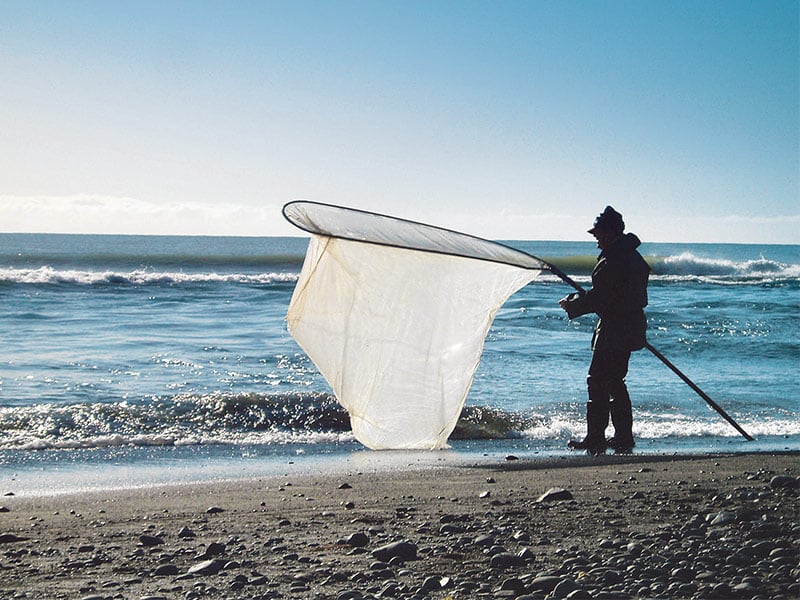Whitebaiting: the tangibles and intangibles
4 min read
Scoop-netting is an energetic form of whitebaiting but highly productive in the surf. Pictured here is a whitebaiter inspecting his catch. Photo: Ben Hope
Whitebaiting is an annual Kiwi passion. It can be energetic or can be laid back. At the end of either style is the likelihood of delicious whitebait patties, splattered with lemon juice.
The energetic approach involves scoop-netting the incoming surf at a river or stream mouth. The relaxed approach is set-netting i.e. a stationary net while you just sit, watch, and lift the net when a shoal swims in. A white ‘sighter board’ just downstream of your set net can help you spot a shoal about to enter your net.
One of the most exciting aspects of whitebaiting is the unpredictability – whitebait shoals can turn up anywhere and any day.
Whitebait spawn in the autumn in swampy margins of rivers and lakes and then descend to the sea – basically a parallel to quinnat salmon. Over the winter, whitebait grow in the sea but are at the mercy of predators such as kahawai, birds, and the vagaries of the ocean currents and storms. Despite these gauntlets to run while at sea, whitebait shoals return in the spring to the river and face more predators such as whitebaiters.
The arrival of whitebait shoals is largely unpredictable. There may be meagre runs, then the next day, big runs come into river mouths. It’s anybody’s guess as to where and when a large shoal turns up.
But with a bit of knowledge and nous, you can minimise the uncertainty. For instance, experienced whitebaiters reckon an optimum time to expect good runs is just either side of the full moon when tides are highest. Pick up a copy of the tide tables and work out those best times. If there’s rain upcountry and a bit of a fresh in the river, then that seems to stimulate good runs. Combine that highest tide moon phase with a fresh in the river and you are likely to score some good catches.
In the North Island, main whitebaiting areas are located from Auckland south, particularly rivers between Taranaki and Wellington. The South Island has a good whitebait fishery with the West Coast often providing bumper catches.
A popular net is the scoop in which fishers net the incoming waves. But take care for that rogue bigger wave can sweep whitebaiters off their feet. So, play it safe and wear a life vest.
Set-netting is a more relaxing form of whitebaiting – a watch-and-wait game on the edges of estuaries of rivers and streams. Further upstream, set netting even above the tidal limit can be successful.
But there will be blank days. My mate – more experienced than me – reckons more than 90% of the whitebait are caught within 10% of total fishing time. So, timing relative to the moon, tides, and river flow can be important.
A good fisher is observant. Birds give a clue, especially terns, as they will hover above the waves when a whitebait shoal is approaching the river. Terns excitedly hovering just above the water or shags fishing is an indicator of whitebait being around. Kahawai or sea-run trout crashing and swirling is another pointer that whitebait are in.
Whitebaiting has intangible spin-offs, too. There’s the social side of chin-wagging with other whitebaiters, swapping theories and even perhaps telling a few tall fishing stories. Then there’s the obvious advantage of spending time in nature, particularly with set netting. Sit there on a still sunny, warm morning and soak it all up. Watch the birdlife, perhaps a grey heron, stalking the water’s edge, or a kingfisher or two diving into the water, probably grabbing whitebait – another indicator to note.
In set-netting, take a cue from the heron and keep still and avoid sudden movements. Whitebait are wary and any sudden movements can spook them. Wear sombre, natural-coloured clothing or even camouflage, hunting clothing.
Also, always remember to release any whitebait with dark bellies and any other fish species caught. A bucket with a lid is advisable and even some iced water mixed with river water to keep the catch fresh.
The whitebait fishing season now runs from 1 September to 30 October inclusive nationwide, except for the Chatham Islands, where the season runs from 1 December to the last day of February inclusive. But check regulations. Ignorance is no defence should a ranger chance along.
Often seasons start slowly in September, but then the main run occurs in October. Nearing high tide can often see an increased surge resulting in better catches. Keep a diary and note the tides and catches and you’ll see patterns emerging, giving you valuable data for future seasons.



